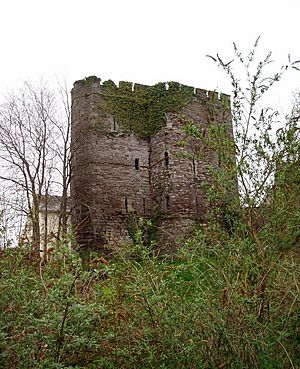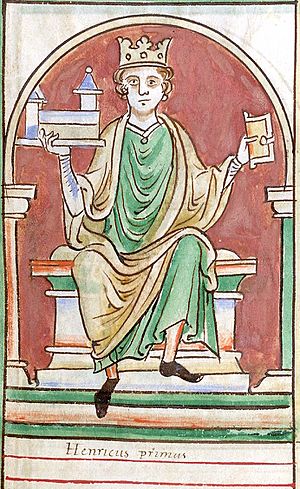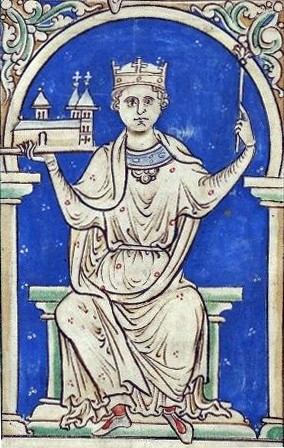Sibyl de Neufmarché facts for kids
Quick facts for kids
Sibyl de Neufmarché
|
|
|---|---|
| Countess of Hereford suo jure Lady of Brecknock |
|
| Born | c.1100 Brecon Castle, Brecon, Wales |
| Died | after 1143 Llanthony Secunda Priory, Gloucester, England |
| Buried | Llanthony Secunda Priory |
| Noble family | Neufmarché |
| Spouse(s) | Miles de Gloucester, 1st Earl of Hereford |
| Issue | Margaret of Hereford Roger Fitzmiles, 2nd Earl of Hereford Walter de Hereford Henry Fitzmiles Mahel de Hereford William de Hereford Bertha of Hereford Lucy of Hereford |
| Father | Bernard de Neufmarché, Lord of Brecon |
| Mother | Nest ferch Osbern |
Sibyl de Neufmarché (born around 1100, died after 1143) was a very important noblewoman. She was known as the Countess of Hereford and the Lady of Brecknock in her own right (suo jure). Sibyl inherited a lot of land and power in the Welsh Marches, which was a border area between England and Wales. She was also related to the royal family of Wales and important noble families in England and Normandy.
Sibyl became the owner of her father's lands and titles, including the Lordship of Brecon. This happened because her mother, Nest ferch Osbern, said that Sibyl's brother, Mahel, was not her father's true son. Most of Sibyl's lands became part of her dowry (a gift of property given when a woman marries) when she married Miles de Gloucester, 1st Earl of Hereford. King Henry I himself arranged their marriage in 1121. Sibyl's huge landholdings were key to the King's plan. He wanted to make the Anglo-Norman rule stronger in south-east Wales. He did this by combining Sibyl's lands with those of Miles, who was a loyal supporter.
As an adult, Sibyl lived through a very difficult time in England. This period was called the Anarchy, during the reign of King Stephen. Her husband, Miles, played a big part in these events. After Miles died by accident in 1143, Sibyl decided to live a religious life. She joined Llanthony Secunda Priory in Gloucester, England. She had given money to this priory years before. Sibyl is buried at the priory, which Miles had started in 1136.
Contents
Sibyl's Family History
Her Birth and Parents

Sibyl was born around the year 1100 at Brecon Castle in Brecon, Wales. She was the only daughter of Marcher Lord Bernard de Neufmarché, who was the Lord of Brecon. Her mother was Nest ferch Osbern. Nest's family was also very important. Her mother was Nest ferch Gruffydd, and her grandfather was Gruffydd ap Llywelyn, who was a king of Wales.
Sibyl's father, Bernard, was born in a castle called Le Neuf-Marché-en-Lions. This castle was on the border between Normandy and Beauvais in France. Bernard was a brave knight who fought for English kings like William I, William Rufus, and Henry I. Historians say Bernard de Neufmarché was one of the first Norman conquerors of Wales. He led the Norman army in the Battle of Brecon in 1093. During this battle, Rhys ap Tewdwr, the last Welsh king, was killed. This allowed Bernard to take control of the area called Brycheiniog. He became the first ruler of the Lordship of Brecknock. This important title and land stayed in his family until 1521. The name Neufmarché means 'Newmarket' or 'Newmarch' in English.
How Sibyl Inherited Her Lands
Sibyl had two brothers. Philip probably died when he was young. Her other brother was Mahel. However, Sibyl's mother, Nest, told King Henry I that Mahel was not Bernard's son. This meant Mahel could not inherit the lands.
Some historians think King Henry I put a lot of pressure on Sibyl's parents to disinherit Mahel. This would allow Sibyl to inherit the lands instead. This way, the lands would go to Miles, who was the King's loyal supporter. Because of Nest's statement, Sibyl became the only rightful heir. She inherited the huge Lordship of Brecon. This was one of the most important and valuable landholdings in the Welsh Marches.
King Henry I's marriage agreement for Sibyl listed all the lands she would bring. These included Talgarth, the forest of Ystradwy, Hay Castle, and all the land of Brecknock. This made her the Lady of Brecknock in her own right when her father died. She became one of the richest heiresses in south Wales.
Sibyl's Marriage and Children
Her Marriage to Miles

In April or May 1121, Sibyl married Miles (also known as Milo) FitzWalter de Gloucester. When Miles's father died in 1129, Miles became the sheriff of Gloucester and the Lord High Constable of England. King Henry I personally arranged this marriage. Miles was a trusted official to the King.
A special document, called a maritagium, was written in Latin in 1121. It recorded the plans for Sibyl and Miles's marriage. One historian, C. Warren Hollister, noted that the King gave Sibyl away as if she were a piece of land. The document said: "Know that I [King Henry I] have given and firmly granted to Miles of Gloucester Sibyl, daughter of Bernard de Neufmarché, together with all the lands of Bernard her father and of her mother after their deaths..." This meant Miles would get all her parents' lands after they died. The King also ordered that all the people living on these lands should promise loyalty to Miles as their new lord.
King Henry I arranged many marriages like Sibyl's. This helped him change the map of power in south-east Wales. These marriages were good for everyone involved. Miles's marriage to Sibyl was a huge step forward in his career. The new lords, like Miles, were loyal to the King. They helped him carry out his plans for the kingdom. Sibyl's father died around 1125. Miles then took control of all her inheritance. When combined with his own lands, it formed a very large estate.
Sibyl and Miles's Children
Sibyl and Miles had eight children together:
- Margaret of Hereford (born 1122 or 1123, died 1197). She married Humphrey II de Bohun and had children. Margaret later became the constable of England and managed the lands of Herefordshire after her husband died.
- Roger Fitzmiles, 2nd Earl of Hereford (born before 1125, died 1155). He married Cecily FitzJohn. They did not have any children.
- Walter de Hereford (died 1159 or 1160). He went to Palestine in 1159 and died soon after. He did not have any children.
- Henry Fitzmiles (died around 1162). He married a woman named Isabella but had no children.
- Mahel de Hereford (died 1164). There is no record of him marrying or having children.
- William de Hereford (died 1166). There is no record of him marrying or having children.
- Bertha of Hereford (born around 1130). She married William de Braose, 3rd Lord of Bramber and had children.
- Lucy of Hereford (died 1219 or 1220). She was the Lady of Blaen Llyfni and Bwlch y Dinas. She married Herbert FitzHerbert of Winchester and had children.
Life During The Anarchy
After King Henry I died in 1135, his nephew, Stephen of Blois, took the throne. But Henry's daughter, Empress Matilda, also claimed the throne. Many powerful lords, including those in the Welsh Marches, supported Matilda. Matilda had returned to England in 1125 after her first husband, the Holy Roman Emperor, died. Her father, King Henry I, had made all the important lords promise to support Matilda as his heir. Matilda later married Geoffrey Plantagenet, Count of Anjou in 1128. They had three sons, and their oldest son later became King Henry II of England.
At first, Sibyl's husband, Miles, supported Stephen. Around 1136, Stephen gave Miles control of all the lands of Gloucester and Brecknock. He also made Miles the Constable of Gloucester Castle. Miles became known as one of Stephen's main supporters.
Llanthony Priory was a monastery built in Wales in 1118. Miles's father had retired there. But after King Henry I died, there was a lot of unrest in Wales. The area around the priory became dangerous, and the monks had to leave. Miles built a new priory for them in Gloucester, England, in 1136. They called it Llanthony Secunda. After 1137, Sibyl and Miles gave more money and land to Llanthony Secunda.
In 1139, Miles changed his loyalty and began to support Empress Matilda. Historians believe Miles supported Matilda because it was practical, not because he believed in her claim more. He needed to join forces with Matilda's powerful half-brother, Robert, 1st Earl of Gloucester, who controlled some of Miles's lands. King Stephen punished Miles for leaving him by taking away his title of 'Constable of England'.
On July 25, 1141, Matilda rewarded Miles for his support and help in battles. She made him the 1st Earl of Hereford. He also received St. Briavels Castle and the Forest of Dean. At this time, Matilda was basically ruling England. Stephen had been captured and imprisoned after the Battle of Lincoln. Sibyl was then called Countess of Hereford. Miles also received the land of Abergavenny from Brien FitzCount. This was because Miles had used clever military tactics to save Brien's castle during King Stephen's attack. Matilda approved this transfer of land.
During the Anarchy, which was the name for King Stephen's chaotic reign, life was very difficult in Miles's lands. Sibyl would have suffered too, especially after Miles decided to support Matilda against Stephen. When Matilda was defeated in Winchester in late 1141, Miles had to return to Gloucester feeling defeated. In November of that year, Stephen was released from prison and became King of England again.
Sibyl's worries would have grown in 1143. The Bishop of Hereford, Robert de Bethune, placed a ban on Hereford. He blocked all the entrances to the cathedral with thorns and removed Miles from the Church (excommunicated him). Miles had demanded money from all the churches in his earldom to pay his soldiers and help Matilda. The bishop said this was against the law. When the bishop protested, Miles sent his men to take resources from the church lands. King Stephen then gave the title "Earl of Hereford" to Robert de Beaumont, 2nd Earl of Leicester. This was to get back at Miles for attacking Worcester and the castles of Hereford and Wallingford. However, Miles never gave up his earldom or title to Robert de Beaumont.
Sibyl's Later Life and Death
On December 24, 1143, Sibyl's husband, Miles, was accidentally shot and died while hunting deer in his own Forest of Dean. He was involved in legal arguments with the bishop when he died. Their oldest son, Roger, became the new Earl. Roger was very angry about his father being excommunicated. He remained an enemy of the Church until near the end of his life when he became a monk in a Gloucester monastery.
After her husband's death, Sibyl chose to live a religious life. She joined Llanthony Secunda Priory in Gloucester, which she had supported before. Sibyl was buried in the same priory. The exact dates of her death and burial are not recorded.
Sibyl's Lasting Impact
When Roger died without children in 1155, the Earldom of Hereford was put on hold. It was not until 1199 that King John gave the title to Henry de Bohun, 1st Earl of Hereford. Henry was Sibyl's grandson through her oldest daughter, Margaret.
Since all of Sibyl's sons died without legitimate children, her three daughters became co-heirs to the Brecon lands. Bertha, the second daughter, passed Sibyl's inheritance to the de Braose family through her marriage. This made the de Braoses one of the most powerful families in the Welsh Marches.
The Brecknock lordship eventually went to the de Bohun family. This happened through Eleanor de Braose, who was a descendant of Sibyl through Bertha of Hereford. Eleanor married Humphrey de Bohun, who was the son of the 2nd Earl of Hereford. Eleanor and Humphrey's son, Humphrey de Bohun, inherited the titles in 1275.
|



